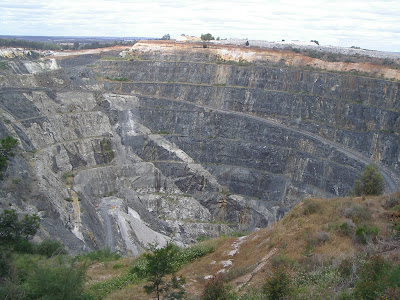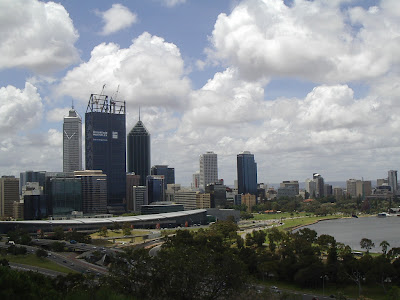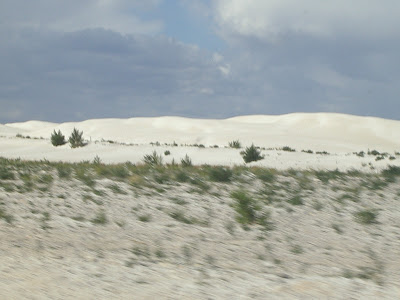Being into our second week in the suburbs we decided to take a trip for a few days (without the van) and travel north of the city along the coast before turning inland and returning through part of the wheat belt.
Our first day was fine and sunny and quite warm. The drive along the Mitchell Freeway was trouble free and within an hour of leaving we were well clear of the suburban sprawl and driving into Yanchep for morning tea. The ocean was green and clear against the white sands of the beaches.
Our parking stop for our break was above the lagoon area where there is a border of reef providing a safe area for swimming by families. There were quite a few mums with little children enjoying the water whilst we were there. We also encountered a multitude of flies, ladybirds and another flying insect about the size of a small wasp (with no sting) that mugged us as soon as we set foot outside the car. This pattern was to continue for the rest of the day at every stop we made. Seems this is the result of being a ‘good’ season for breeding following rain earlier in the year. It certainly made for an interesting day!
Leaving Yanchep our road then changed from Wanneroo Road to the new Indian Ocean Drive. This coastal road to Geraldton was only completed earlier this year and provides easy access to the small coastal communities along this scenic west coast. We called in to each of them as we travelled towards Cervantes and the Pinnacles Desert Park.
mouth of the Moore River at Guilderton
Guilderton at the mouth of the Moore River, Seabird, Ledge Point and Lancelin are all small communities started by fisherman that all offer pristine water and beaches.
the beach at Lancelin
I am sure that during school holiday time they are all quite busy with visitors. They all have small permanent populations (a few hundred folk at most) and provide basic services and offer a relaxed holiday time for all. No freebie camping sites however and there are many signs advising this. We were quite surprised as to how clean each of the settlements looked. Even the older homes and cottages were still neat and tidy so a big congratulations to all those that live in these delightful areas.
Bobtail at the Pinnacles Desert Park
It was mid-afternoon before we arrived at the Pinnacles Desert Park and after visiting the Interpretive Centre and gift shop for a quick look around, we then took the 4km self-drive tour through the park. What a fascinating time.
These amazing limestone structures were created from ancient shells, remnants of another epoch rich in marine life. Over the millennia, natural processes have combined to remove surrounding material to result in the limestone pinnacles jutting out from their surrounds today. Dutch sailors who first sighted the area in the mid 1650’s mistook the Pinnacles for ruins of an ancient civilisation.
W A's grass tree in flower
Our first overnight stop was at the Cervantes Pinnacles Motel and the most expensive ‘standard’ room we have ever had. $145 per night, very basic room and not even a toaster to use. Yes there was shower gel, hand wash, shampoo etc but no gilt taps or silk sheets so, quite a little overpriced.
Next morning we drove out to the nearby Lake Thetis and the interesting stromatolites. This is one of just 5 sites in WA where they can be seen. They grow in the lake and are made up of the oldest known organisms on earth. Some fossil remains have been dated as old as 3.6 billion years! The area has interpretive signposts around the lake and especially at the viewing platform where photos can easily be taken.
stromatolites at Lake Thetis
Leaving the Cervantes area we head further up the coast to Jurien Bay (the biggest settlement, approx.1600) a fishing town. Offshore is the Jurien Bay Marine Park which is sheltered by a string of islands and reefs that protects a unique mix of tropical and temperate species including sea lions, dolphins and breeding seabirds.
Green Head is our last stop on the coast and we stopped for lunch at Dynamite Bay where we enjoyed a chat with Steve who is travelling on his own in a camper van and had some interesting stories to tell. The flies thankfully were not so bad as yesterday and we could eat outside the car.
Our trip then turned us inland away from the main highway towards Eneabba and that was when the wildflowers started again. We continue to find new and different plants and so the photo finger gets a workout again. Fortunately with not having the van behind, doing a u turn in order to check another one out is no big drama.
quandong
banksia we found along the way
sandhills near Cervantes....anyone for a slide?
The threatening showers start to set in during the afternoon and the last hour or so into Carnamah where we plan to stop is through quite solid rain, so even though the road verge is covered in mauve flowers I cannot get a clear photo, but it still looked delightful.
Our third day saw us turning for home along some back roads down to Moora and then out to the Great Northern Highway so that we could call into New Norcia. This area is home to a community of Benedictine monks who own and operate the town.
Olive trees, church bells and 27 magnificent Spanish-style buildings (classified by the National Trust) sit naturally in the bush landscape. The museum and art gallery contain one of the finest collections of moveable heritage in Australia. It houses artworks by Spanish and Italian masters, gifts from the Queen of Spain and a fascinating array of artefacts which tell the story of New Norcia’s time as an Aboriginal mission, a centre of the monks’ extensive farming activities and as a place of education and culture.
Once more down though Bindoon and into the Swan Valley, through vineyards and past horse spelling paddocks. Just look at all those young foals with their mums.
Our three days away has been an enjoyable time for us both and we have certainly enjoyed the beauty and diversity of the areas we have travelled through.















































